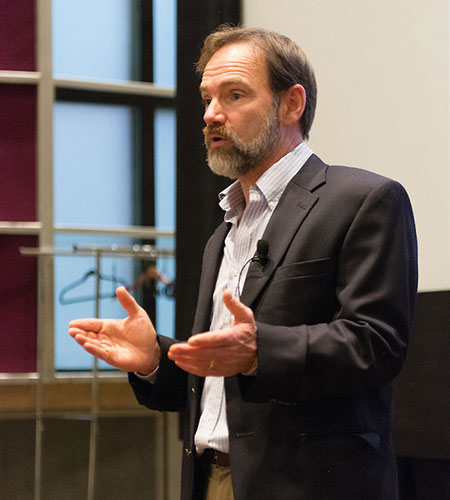’Text or Die’ talk with students
A man on a crusade to end distracted driving—after his 21-year-old daughter was struck and killed in a crosswalk by a driver adjusting his GPS in 2009—spoke with Emerson students September 9, asking to help spread awareness.
“I’d love to see you guys out there communicating this message and making a difference,” said Joel Feldman, who spoke at the Bordy Theater to students primarily from the Communication Studies Department, several of whom are producing public service announcements about distracted driving for their classes. “Safe, non-distracted driving is what should be expected of all of us.”

Joel Feldman of Pennsylvania speaks about the 2009 distracted driving death of his 21-year-old daughter, Casey, at the Bordy Theater on September 9. (Photo by Michelle Kwong '15)
Feldman and his wife, Dianne Anderson, who was also in attendance, lost their daughter, Fordham University journalism student Casey Feldman, as she crossed a street in Ocean City, New Jersey, in the daylight hours five years ago.
“The last time we were here was when we toured Emerson with [Casey],” Feldman said. “I think if Emerson were closer to Philadelphia, where we’re from, she would have gone here. She wanted to be a reporter.”

Casey Feldman died at age 21 in 2009 after being struck in a crosswalk by a distracted driver. (Courtesy Photo)
During a discussion with the audience, Feldman—who formed the Casey Feldman Memorial Foundation—asked students to admit distracted driving behavior they have engaged in or witnessed. One student said his friend often smokes cigarettes and talks on the phone while simultaneously driving a stick-shift car. Another said she texts and has even done homework while behind the wheel.
Feldman showed a video of a public bus driver writing on a clipboard for several minutes, which was taken on a cell phone by an angry passenger. He also showed a public service announcement in which a Groton, Massachusetts, college-aged woman talks about the impact of accidentally killing a pedestrian because she adjusted her GPS unit while in motion, causing her car to veer into a breakdown lane.
“I will admit that I am still tempted to use my phone [while driving] even though I lost my daughter,” said Feldman, adding that he will not do so because he created a plan for himself.
Feldman said there are smartphone apps available on some phones—but notably not currently available on iPhone—that automatically send response text messages saying the person trying to be reached is driving and cannot respond. Students also suggested shutting off one’s phone before driving.
Feldman cited a long list of statistics showing that using a cell phone while driving—even with hands-free technology—greatly increases the chances of an accident.
Phillip Glenn, interim dean of Emerson’s School of Communication, told the audience that distracted driving is a “powerfully important topic” and that “communication is at the heart of dealing with these issues.”
“There is not an easy solution,” he said.
Gregory Payne, associate professor and interim chair of Communication Studies, said many of the students would be producing public service announcements that they would send to Feldman during this school year. Feldman’s lecture, titled “Text or Die,” was sponsored by Communication Studies in conjunction with a grant from InBev to promote healthy living.
Categories